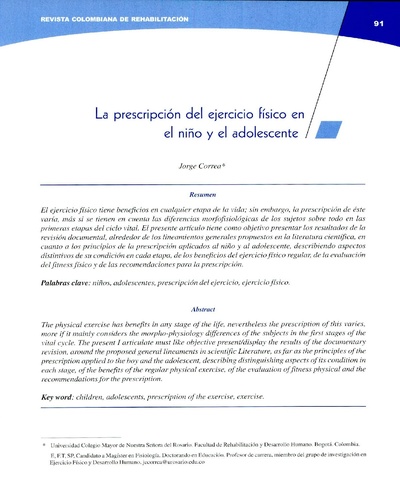La prescripción del ejercicio físico en el niño y el adolescente
Contenido principal del artículo
Autores
Jorge Correajecorrea@urosario.edu.co
Resumen
Palabras clave:
Detalles del artículo
Licencia
Aquellos autores/as que tengan publicaciones con esta revista, aceptan los términos siguientes:
- Los autores/as conservarán sus derechos de autor y garantizarán a la revista el derecho de primera publicación de su obra, el cuál estará simultáneamente sujeto a la Licencia de reconocimiento de Creative Commons que permite a terceros compartir la obra siempre que se indique su autor y su primera publicación esta revista.
- Los autores/as podrán adoptar otros acuerdos de licencia no exclusiva de distribución de la versión de la obra publicada (p. ej.: depositarla en un archivo telemático institucional o publicarla en un volumen monográfico) siempre que se indique la publicación inicial en esta revista.
- Se permite y recomienda a los autores/as difundir su obra a través de Internet (p. ej.: en archivos telemáticos institucionales o en su página web) antes y durante el proceso de envío, lo cual puede producir intercambios interesantes y aumentar las citas de la obra publicada. (Véase El efecto del acceso abierto).
Los autores que publican en la revista se acogen al código de licencia de Creative Commons Atribución 4.0 Internacional (CC BY 4.0)




Referencias
ACSM(2000). Manual de consulta para el control y la prescripción del ejercicio". Barcelona, Paidotribo
American College of Sport Medicine (1990). The recommended quantity and quality of exercise developing and maintaining cardio respiratory and muscular fitness in healthy adults. Med Sci Sport Ecerc. 22:265-274.
AMERICAN HEART ASSOCIATION AHA, Children`s Need for physical Activity: Fact sheet. Accessed june 2003 (www.americanheart.org)
AMERICAN ACADEMY OF PEDIATRICS (2001). Commintte on Sports, Medicine and Fitness Strengh Training by Children and Adolescents.
Bar-Or (1989). Trainability of the prepubescent child. Phys. Sportmed, 17: 65-81.
BERG A and KEUL. J (1988) Bichemical change during exercise in children. In: Malina, RM (ed). Young Athletes. Biological, Psychological, and Educational Perspectives, 61-77. Champaign. IL: Human kinetics.
BLIMKIE, USDHHS. MMWR March 7, 1997 Guidelines for school and Community Programs to promote Lifelong Physical Activity Among Young People.
Centers for Disease Control and Prevention. U.S. Department of Health and human services public health services. Morbidity and Mortality Weekly Report on Recommendations of the task Force on Comunity Preventive Services. Also published in Amercian Journal of prevention Medicine 2002:22(4S). 67-72.
Centers for Disease Control AND prevention (CDC) National Center for chronic disease prevention and health promotion, Ntirition and physical Activity. National bone health campaign. Accessed in August 2003.
Centers for disease Control and Prevention (CDC) and president`s Council on physical fitness and sports. Healthy people 2010. Leading Health indicators.
Daniels J and OLDRIDGE N (1971). Changes in Oxygen consumption in young boys during growth and running training. Med Sci Sports. 3:161-165
Drinkwater BL, kUPPART IC, Denton Je, et al. (1977). Response of prepubertal girls and college women to work in the heat. J A PPL Physiol: 43.
Drinkwater BL, HORVATH SM (1979). Heat tolerance and aging. Med Sci Sport Exerc, 11: 49-55.
Falk B, Tenekbaum G (1996). The effectiveness of resistance training in children A metaanalysis. Sports Med,3: 176-186.
Faigenbaum AD. Zaichkowsky LD, Westcott WL. MICHEL LJ, FEHLANDT AF(1993). The effects of a twice-a-week strength training program on children. pediatr Exerc Sci, 5:339-346.
HARRIS JO,CALE LORRAINE (200&). A reviex of children´s fitness testing. European Physical Education Review. 12:201-225.
HEYWARD. VIVIAN H (2001). Evaluación y prescripción del ejercicio. valoración de la fuerza y de la resistencia muscular. Cap. 4. 2a ed.. Ed España. Paidotribo.
MC ARDLE WD. KATCH FI and Katch VL (1981). Exercise physiology,energy nutrition and human performance. Philadelphia Lea & Febiger.
NURMI-LAWTON JA. BAXTER-JONES A. TAYLOS P. COOPER C. BISHOP J. NEWS (2004). Dietary balance in physical active and in-active girls. in Nutritional aspects of osteoporosis. Burckhardt P. Dawson. hughes B. Heaney RP (eds.) San Diego: Elsevier Science. Chapter 31: 411-418.
PATRICK K. SPEAR B. HOLT K. SOFKA D. (eds) (2001). Bright futures in practice: physical activity : arlington. VA: National Center for Education in Maternal and Child Health.
PATE RR SMALL ML. ROSS JG. YOUNG JC. FLINT KH & WARREN CW (1995). School Physical education journal of school health. 65(8): 339-343. EJ 520 865.
PROMOTION AND THE PRESIDENT´S COUNCIL ON PHYSICAL FITNESS AND SPORTS (PCPFS). Physical Activity And Health- A report of the Surgeon General. 1996
RAMMASAY JA. BLIMKIE CJ. SMITH K. GARNER S. MACDOUGALL J. SALE DG (1990). Strength training effects in prepubescent boys. issues and controversies. Med Sci Sports Exerc. 22: 605-614.
ROWLAND TW (1990). Exercise and children´s health. champaign. I.L: Human Kinetics.
ROWLAND TW (1985). Aerobic response to endurance training in prepubescent children: a critical analysis. Med Sci Sports Exerc. 17: 493-497.
ROWLAND TW. STAAB N. UNNITHAN V AND SICONOLFI S (1988). Maximal cardiac responses in presubertal and adult male (abstract) Med Sci Sport Exerc 20 (SUPPL.) S32.
SALLIS JF. PROCHASKA JJand Taylor WC. (2000). A Reviw of correlates of physical activiy o f children and adolescents. Med Sci Sports Exerc. Vol 32. No 5. 963-975.
SOTHEN MS. LOFTIN M SUSKIND RM. UDALI JN. BLECKER U (1999). The health benefits of physical activity in children and adolescents: implication for chronic disease prevention. European journal of pediatrics. 158: 271-274.
The cooper institute for Aerobics Research. (1999). FITNESSGRAM test administration manual. Champaign. IL: Human Kinetics, The president´s council on physical Fitness and Sports (PCPFS). Physical Activity and health- A report of the surgeon General . 1996.
US Departmen of Health and Human Services (USDHHS). Office of the assistance Secretary for Planning and Evaluation. Physical Activity Fundamental to prevening disease. June 20.2002.
USDHHS Physical Activity Fundamental to preventing Disease (2002)
WAGNER JA. ROBINSON S. TZANKOFF SP et al. (1972). heat tolerance and acclimatization work in the heat in relation to age. J Appl Physiol. 33: 616-622.
WILMORE JH. COSTILL DL (2004). Fisiología del ejercicio y del deporte. Barcelona: Ed. Paidotribo.
YUCRA (2001). Algunas consideraciones para la utilización de las baterías de test de la condición física http//www.efdeportes.com/ Revista Digital -Buenos Aires-Año 7-N 38. Julio.


 PDF
PDF










